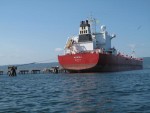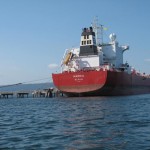
By Miranda Weiss, June 25, 2015, Homer News
A massive red-hulled ship tied up at the Deep Water Dock last week. The 750-foot-long M/V Marika was an impressive sight as it dwarfed structures on the Spit. It stayed through the weekend and then untied and set anchor in the bay just in time for the M/V Statendam cruise ship to slip in on Tuesday morning. The 817-foot-long Minerva Antarctica is scheduled to arrive today and remain through Sunday.
Both the Minerva Antarctica and Marika are support vessels for Royal Dutch Shell’s operations in the Arctic’s Chukchi Sea this summer. The Minerva Antarctica is a spill response vessel and the Marika, laden with low sulfur diesel, is a refueling tanker, which will provide fuel to other supply vessels. Shell is moving two drill rigs, 25 support vessels, aircraft and about 1,900 people to Alaska this summer, staging out of Dutch Harbor, Barrow, Kotzebue Sound and Wainwright.
With the arrival of these ships, you can see what it means for Homer to be a working port. Harbormaster Bryan Hawkins met the Marika at 6 a.m. as the ship tied up. He or one of his staff members observe the landing of every large ship at the Deep Water Dock, ensuring a record of any damage that might occur to the facility.
Then, Hawkins set out making sure all of the Department of Homeland Security-mandated measures were in place, which is required when any federally regulated vessel comes to port. Regulated vessels include foreign-flagged vessels, large passenger ships (including cruise ships), and vessels carrying dangerous cargo. Hawkins and his staff maintain a four-inch-thick Facility Security Plan, which must be renewed every five years. Also federally mandated is a security presence at the dock: a local business has been providing a security officer at the Deep Water Dock around the clock while these ships are in port.
Not long after the ship arrived, Lt. Bill Albright with the Coast Guard’s Marine Safety Detachment in Homer sent four personnel onboard for a detailed safety inspection of the ship, which lasted about four and a half hours. They observed safety drills, checked lifesaving gear and pollution controls, inspected the ship’s licensing and otherwise ensured that the ship met the International Maritime Organization’s standards.

